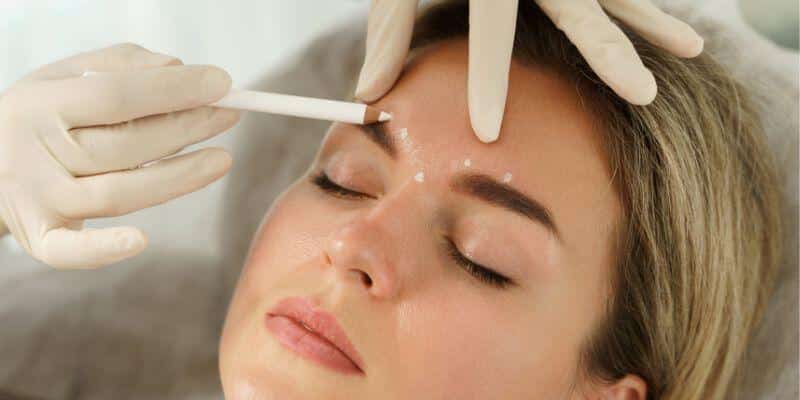
Dermal filler are one of the most popular cosmetic treatments available today. While more and more men and women have experienced dermal fillers for themselves, many people have yet to try fillers for themselves. To help out, we’ve put together the top Frequently Asked Questions on dermal fillers.
What are Dermal Fillers?
Dermal fillers are medical gels injected beneath the skin’s surface to smooth out wrinkles and lines, and add volume and contour facial features. Most dermal fillers are composed of stabilized hyaluronic acid (HA) which occurs naturally in the cells of the skin. It functions by attracting water and therefore augmenting the skin, and reducing the visible signs of aging. Dermal fillers are temporary formulas, that dissolve safely over time. Depending on what type of dermal fillers are being used, and the area of the face, results can last between one to two years. Dermal fillers are very safe and have been used for over a decade.
What areas can dermal fillers be used for?
The face loses its youthful volume and contour when we age, as the soft tissues dissolves, leading to wrinkles, lines and sagging. Dermal fillers may be used to replace this volume loss and restore structural support, giving the patient smoother skin and a more youthful appearance. Areas such as the lips may be treated to improve their shape, size, and proportion. The cheeks might be treated to make a face more defined and attractive. An underdeveloped chin may be injected to make it appear more projected and proportionate. And the nose may even be injected to improve the its shape and contour.
What does the procedure entail and is it painful?
Most dermal filler procedures require no separate anesthetic, as the dermal fillers themselves contains local anesthetic. Treatment is simple and straight-forward, involving a few tiny injections directly into the skin, typically requiring only 15-30 minutes. Most make-up can be applied immediately after the procedure, and you can go straight back to work. Optimal results can be maintained and extended over a long period of time through regular repeated treatments. Note that the procedure will vary from person to person depending on personal requirements, the severity of the wrinkles being treated, and the particular dermal filler(s) being administered.
How soon will I see any result and how long does they last?
Results are typically seen instantly after the treatment, and will gradually improve over the course of the following 1-2 weeks. Treatment results can last between 9-18 months, and optimal results can be maintained over a longer period of time through regular repeated ‘touch up’ treatments. The longevity varies from person to person depending on the severity of the condition(s) that are being treated, the patient’s physiology and lifestyle habits.
Are dermal fillers safe?
Yes, most definitely. For instance, hyaluronic acid, the most common dermal filler base ingredient, is a substance which occurs naturally in the cells of the skin, and therefore there is very little risk of allergic reactions. Even people with food sensitivities can receive most dermal fillers safely. Dermal fillers have undergone clinical testing, and have been used safely in countries around the world for many years.
Are there any side effects?
Today’s dermal fillers have come a long way since the earlier, first-generation of collagen injections. Advanced injection techniques, and improved product safety, means that significant side effects are extremely uncommon, but may include:
- Injection
- Bruising.
- Contour irregularities
- Infection
- Necrosis.
- Blindness
Are there any after-care instructions?
After treatment, your injector team will review with you any after-care advice in order to maximize your treatment benefits and avoid any undesirable side effects. Patients can resume normal activities, or return to work immediately after the treatment. As with any type of injection there may be some slight redness and tenderness immediately afterwards. In most cases, subtle camouflage make-up may be applied. The results visible immediately after the treatment should not be seen as the final results. This is because over the following 2 weeks the results will gradually improve on their own. For 2 weeks after the treatment, patients are advised to avoid extreme heat (sun bed or sunbathing) or intense cold.
Conclusion
Dermal fillers continue their rise in popularity, with more and more men and women trying them for the first time on a regular basis. Skilled and experienced aesthetic doctors and licensed injectors are helping patients rejuvenate their look safely and conveniently, with the help of dermal fillers.

About the Author: Doris Dickson is a specialist writer for Health Supplies Plus, focusing on the aesthetic medicine industry. She diligently researches cosmetic treatments and products to provide clear, concise information relevant to licensed medical professionals. Her work supports Health Supplies Plus’s commitment to being a reliable informational resource and trusted supplier for the aesthetic community.
Disclaimer: The content provided in this article is intended for informational purposes only and is directed towards licensed medical professionals. It is not intended to be a substitute for professional medical advice, diagnosis, or treatment, nor does it constitute an endorsement of any specific product or technique. Practitioners must rely on their own professional judgment, clinical experience, and knowledge of patient needs, and should always consult the full product prescribing information and relevant clinical guidelines before use. Health Supplies Plus does not provide medical advice.

